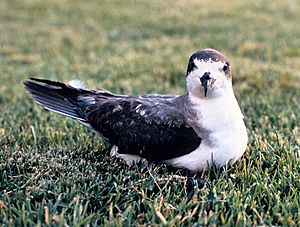Hawaiian petrel facts for kids
Quick facts for kids Hawaiian petrel |
|
|---|---|
 |
|
| Conservation status | |
| Scientific classification | |
| Genus: |
Pterodroma
|
| Species: |
sandwichensis
|
The Hawaiian petrel is a special bird found only in Hawaiʻi. People in Hawaiʻi also call it the ʻuaʻu. It's a type of petrel, which is a seabird. This bird is mostly dark grey-brown on its back and white underneath. It's quite a large bird.
Contents
Where Hawaiian Petrels Live
The Hawaiian petrel used to live on almost all the main Hawaiian Islands. The only island it wasn't found on was Niʻihau.
Today, most Hawaiian petrels live in the Haleakalā crater on the island of Maui. Smaller groups can be found on Mauna Loa on Hawaiʻi island. They also live in Waimea Canyon on Kauaʻi. You might also find them on Lānaʻihale on Lānaʻi, and maybe even on Molokaʻi.
Sometimes, these birds are also seen near the Galapagos Islands.
Hawaiian Petrel Behavior
What Hawaiian Petrels Eat
Hawaiian petrels mainly eat squid, which makes up about half to three-quarters of their diet. They also eat smaller amounts of fish and crustaceans. Crustaceans are like crabs and shrimp.
Hawaiian Petrel Reproduction and Life Cycle
Hawaiian petrels build their nests in burrows or inside cracks in rocks. The nesting season lasts from March to October. The female bird lays just one white egg.
Once the chick hatches, the parent birds fly out to sea to find food during the day. They come back to the nest only at night. They feed their chicks by bringing up food from their stomachs. Young chicks are charcoal-gray. Early Hawaiians thought these chicks were a special food.
Scientists used to think these birds stayed close to Hawaiʻi during nesting. But new studies show they travel very far. They can fly all the way to Alaska and Japan on their two-week-long feeding trips.
Sounds and Flight
When adult petrels return to their burrows at night, they make a unique moaning sound, like "oo-ah-oo." At their nests, they also make different yaps, barks, and squeals.
The Hawaiian petrel flies in a special way. It makes high, steep arcs and glides through the air. Their wings are long and narrow, stretching about 36 inches (91 cm) wide. Their wings and tail are a sooty, dark color. Their feet are pink and black.
Protecting the Hawaiian Petrel
The Hawaiian petrel is an endangered species. This means there are not many of them left, and they need help to survive. One reason they are in danger is because their homes are being lost due to new buildings.
The biggest threats to these birds are feral cats, small Asian mongooses, and rats. These animals hunt and eat the helpless chicks inside their burrows.
In Haleakalā National Park, people are working hard to reduce the number of wild animals like cats and rats. This helps protect the Hawaiian petrel and many other rare Hawaiian birds.
Wires can hurt these rare petrels, and bright city lights can confuse them. This also makes it harder for them to survive. The Hawaiian petrel was once thought to be the same species as the dark-rumped petrel from the Galápagos. However, scientists recently decided they are different species.
To help the ʻuaʻu, Hawaiʻi switched to digital television early, on January 15, 2009. This was a month before the rest of the United States. Biologists did not know exactly how many petrels were left. They guessed fewer than 1,000 nested on Haleakalā volcano, which is their main nesting spot. Switching to digital TV early allowed old TV towers to be taken down without bothering the birds. Their nesting season starts in February.
See also
 In Spanish: Petrel hawaiano para niños
In Spanish: Petrel hawaiano para niños


